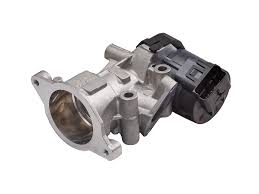What Is an EGR Valve and How Does It Improve Your Vehicle's Performance?
2025-01-06
When it comes to maintaining a vehicle’s engine, many components work together to ensure everything runs smoothly. One such component is the EGR valve—a part that plays a significant role in reducing harmful emissions while optimizing the engine’s efficiency. But what exactly is an EGR valve, and how does it contribute to your vehicle's overall performance?
In this blog, we’ll explore the purpose of the EGR valve, how it works, and why it’s important for both the health of your vehicle and the environment.
What is an EGR Valve?
An EGR valve stands for Exhaust Gas Recirculation valve. As the name suggests, this valve regulates the flow of exhaust gases back into the engine's intake system. The primary function of the EGR valve is to reduce nitrogen oxide (NOx) emissions produced by the engine during combustion.
When fuel burns in an engine, it creates high temperatures. These elevated temperatures can cause nitrogen (a naturally occurring element in the air) to combine with oxygen, resulting in the production of NOx. NOx gases are harmful pollutants that contribute to smog and acid rain. The EGR valve helps to lower these emissions by recirculating a portion of the exhaust gases back into the combustion chamber, effectively lowering the combustion temperature and preventing excessive NOx formation.
How Does an EGR Valve Work?
The EGR system is fairly simple but effective. The exhaust gases, which would otherwise exit through the exhaust manifold, are rerouted back into the intake manifold by the EGR valve. Here's a step-by-step look at how it works:
1. Exhaust Gas Recirculation: When the engine is running, the EGR valve opens based on signals from the engine control unit (ECU). The exhaust gases, which have already gone through combustion, are directed back into the intake manifold.
2. Dilution of Air-Fuel Mixture: By introducing exhaust gases into the intake air-fuel mixture, the oxygen content is slightly reduced. This lowers the temperature of the combustion process.
3. Reduction of NOx Emissions: Lowering the temperature helps prevent the formation of NOx gases because NOx is created at higher combustion temperatures. As a result, the EGR system reduces the vehicle's emissions, helping the engine meet environmental standards.
4. Valve Control: The EGR valve is controlled electronically or vacuum-operated depending on the vehicle's design. Modern vehicles often use electronic valves, which can be more precisely controlled by the ECU.
Why Is an EGR Valve Important?
The EGR valve serves several vital purposes that go beyond simply reducing emissions. Here’s why it’s an important part of your vehicle’s engine:
1. Environmental Benefits:
The primary function of the EGR valve is to reduce harmful NOx emissions, which are a major contributor to air pollution. By lowering the temperature during combustion, the EGR valve helps ensure that fewer nitrogen oxides are produced, helping vehicles meet emission standards set by regulatory authorities.
2. Improved Fuel Efficiency:
Surprisingly, the EGR valve can also contribute to improved fuel efficiency. By lowering the combustion temperature, the engine doesn't have to work as hard to manage the heat. In certain conditions, this can result in a slight increase in fuel economy. The EGR system also helps reduce engine knock, allowing for smoother and more efficient engine performance.
3. Engine Longevity:
The EGR system can help prevent engine overheating. By lowering the combustion temperature, it reduces the strain on engine components, leading to less wear and tear over time. This can help prolong the life of your engine and keep it running smoothly for longer.
4. Enhanced Combustion Process:
By reducing peak temperatures in the combustion chamber, the EGR valve contributes to a more balanced and controlled combustion process. This results in fewer harmful by-products and a more efficient overall engine operation.
Signs of a Faulty EGR Valve
Like any vehicle component, the EGR valve can malfunction over time. If it becomes clogged, stuck, or develops other issues, it can negatively impact engine performance and emissions. Here are some common signs of a faulty EGR valve:
1. Check Engine Light: If the EGR valve is not functioning correctly, it may trigger the check engine light on your dashboard. A diagnostic scan will usually indicate whether the EGR valve is the culprit.
2. Poor Engine Performance: A malfunctioning EGR valve can lead to poor engine performance, such as rough idling, hesitation, or stalling. If the valve is stuck open or closed, it can disrupt the air-fuel mixture, causing the engine to run inefficiently.
3. Increased Emissions: A failing EGR valve will no longer be able to reduce NOx emissions effectively, leading to higher emissions levels. This can result in your vehicle failing emissions tests and contributing to environmental pollution.
4. Poor Fuel Economy: When the EGR system doesn’t operate correctly, it can lead to poor fuel economy. The engine may run hotter, causing it to consume more fuel to maintain the same power output.
5. Engine Knocking: A malfunctioning EGR valve may cause knocking or pinging sounds, especially when accelerating or driving at high speeds. This is because higher combustion temperatures may lead to premature ignition.
How to Maintain the EGR Valve?
Maintaining the EGR valve is relatively simple, but it’s an important part of keeping your engine in good condition. Here are some maintenance tips:
1. Regular Inspections: It’s a good idea to have your EGR valve inspected regularly as part of your routine vehicle maintenance. A mechanic will check for signs of wear or clogging, especially if you notice any symptoms of a faulty valve.
2. Keep It Clean: Over time, carbon deposits can build up in the EGR valve, causing it to get stuck. Regular cleaning or using cleaning additives in the fuel system can help prevent carbon buildup.
3. Timely Replacement: If your EGR valve is clogged or malfunctioning, it may need to be replaced. This is typically an affordable repair, and replacing a faulty EGR valve can restore your engine’s performance and efficiency.
4. Follow Manufacturer Guidelines: Always refer to your vehicle’s owner’s manual for specific maintenance recommendations related to the EGR system.
Conclusion: A Small Part with a Big Impact
The EGR valve may seem like a small and unassuming part of your vehicle, but it plays a crucial role in keeping your engine running efficiently and meeting emission standards. By reducing harmful NOx emissions, improving fuel efficiency, and promoting engine longevity, the EGR valve is an essential component in modern vehicles.
Regular maintenance and timely repairs of the EGR valve ensure that it continues to perform its job effectively. If you notice signs of a malfunctioning valve, addressing the issue early can prevent further damage to your engine and help keep your vehicle environmentally friendly.
In short, while it might not be the most glamorous part of your vehicle, the EGR valve is certainly one of the most important when it comes to maintaining both engine performance and environmental responsibility.



